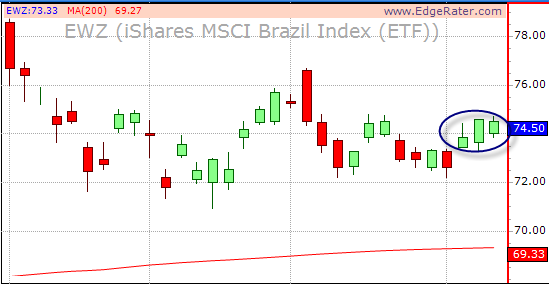When backtesting it is important that the data you use is adjusted for splits and dividends. The necessity of adjustment for splits is more obvious due to the larger effects on price.
For instance if a stock is trading at $40 and gets a 2:1 split, it suddenly appears to be quoted on the exchanges at $20. If the previous prices were not adjusted in some way the chart would look as though there was a huge gap down and that would suggest a bad news announcement or problem with the company. Any indicators that you use for trading would also be affected and might signal a trade entry or exit when in fact there has been no real change in the overall market cap of the company.
To combat this, all price and volume figures prior to the split announcement are back-adjusted using a multiplication factor. In the case of a 2:1 split the multiplication factor is 0.5 for price and 2.0 for volume. So a prior day actual price of $38 now shows on the chart as $19 and a volume of 300,000 shares now shows as 600,000.
The same type of adjustment needs to be made for any cash dividend for all prices prior to the ex-dividend date (an adjustment for volume is not necessary).
Here’s a real-world example from a recent dividend for the Diamonds ETF (symbol DIA):
You can see from the above two charts that an entry was generated in both cases but an exit signal was not generated in the non dividend-adjusted chart.
If you look closely at the candles you can see that the Nov 19th close price is above the prior day’s close when the chart is adjusted and below the prior day’s close when the chart is not adjusted.
So, what has actually happened to your position on November 19th? Well, you were registered to receive your cash dividend payment of $0.361 and the open price for the ETF was changed by the exchange to reflect the fact that it is now worth $0.361 less due to the cash dividend.
The chart that has no back-adjustments for dividends therefore tells a misleading story – it indicates that price fell (which it did) but you got yourself a cash payment of that same amount, so that added to the positive price action for the day meant that price really rose.
When you are back-testing you really need to use a dividend-adjusted data provider to account for these situations. It means that any trade entry/exit prices will be printed as the back-adjusted prices and take into account dividends that are paid out to you.
Also, when looking at charting applications you should be aware if they are showing adjustments for dividends or not. Here’s an example where it really looks like the security is having a bad time, whereas in reality it is behaving very well:
You might be surprised to find out that Yahoo! online charts do not adjust for dividends even though their data contains the Adj Close column. In fact, when EdgeRater uses Yahoo! data it performs the back-adjustment for Open, High, Low and Close automatically and so any charts displayed in EdgeRater are adjusted properly.
StockCharts.com is one online charting application which does the necessary adjustments for dividends.
It’s worthwhile to ask your charting service whether they are adjusting for dividends or not and it’s really important to know whether your back-testing software is using split and dividend adjusted data.




